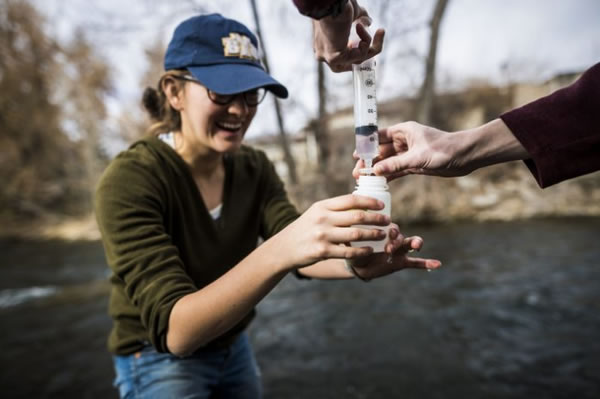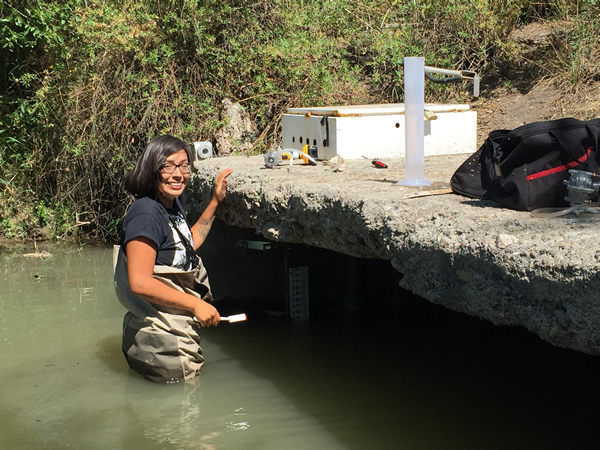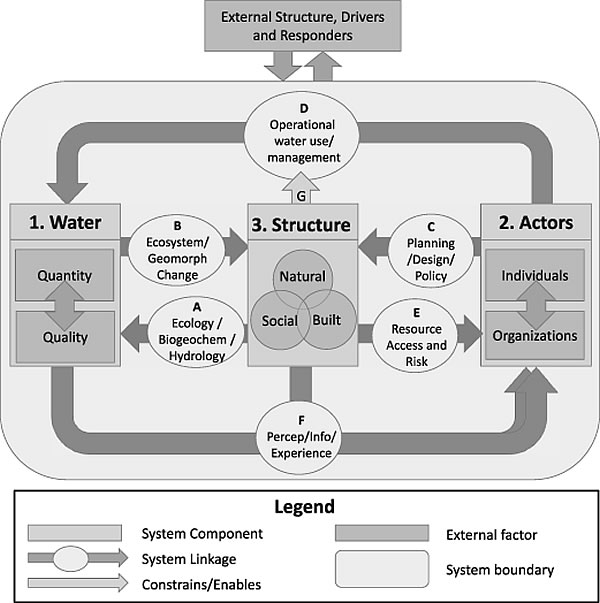News and Highlights
This is a list of past iUTAH EPSCoR news from 2012 to 2018.
March 15, 2018
Citizen Science Project to Improve Utah Lake
iUTAH researcher Erin Jones helped lead a citizen water sampling effort to study and assess rivers and streams that lead into Utah Lake. Aimed at identifying the source of pollutants, this first project involved roughly 150 participants on March 10.
Jones, a teaching assistant for the participating Watershed Ecology class at Brigham Young University, said that around two-thirds of the people involved had contributed to a scientific study before this one. Of the people she talked to, most had some connection to water resources or just a general concern about the environment in general and Utah Lake specifically.
“I think one of my favorite parts about talking with people as they came to pick up their sampling materials or return their filled bottles was to hear about their connection to the watershed,” said Jones. “Many were sampling areas that they were familiar with, but hadn't necessarily ever stopped to think about the water quality there. Other people signed up to go somewhere in the watershed they had never been before, giving them a much deeper connection to place.”
Additional information on the sampling project came from reporter Auburn Remington in a March 7 article in Brigham Young University’s The Daily Universe. “BYU professor Ben Abbott, an ecosystem ecologist and the project director, said the project is focused on sampling by rivers and streams that lead into Utah Lake because they are ‘sensors of ecosystem health. Sampling many places in the river network gives you a high-resolution image, like a computer or a phone screen. If you have more points, you can see more clearly what is going on in a system,’ Abbott said. ‘What’s neat about a river is that it’s a natural organization, and the river has created this tree-like form that extends out into the landscape, and then if we listen to the river or analyze the chemistry of the river, it can tell us what’s happening.’
Abbott said the goal of the project is to identify the non-point sources of nutrients to Utah Lake, or in other words, the nutrients flowing into the lake from things other than pipes. Non-point nutrients include things that flow through the soil, such as fertilizer or contaminated storm water. ‘The other purpose of the study is to get people connected to their watershed, so we appreciate and value what we understand and know,’ Abbott said. ‘If people spend time around Utah Lake and in the rivers flowing to Utah Lake, they’ll realize that this isn’t a trashed or destroyed ecosystem, it’s a beautiful and vibrant environment.’ “
Jones said of those who participated, it would “hopefully increase their awareness and concern about local environmental issues.” The research group hopes to have another event in summer and another class at BYU in the fall to measure seasonal changes in factors such as nutrients. She invites people interested in attending future citizen science samplings of Utah Lake to visit the Utah Lake Research Collaborative website.
Press: The Daily Universe

March 14, 2018
USU's Nancy Huntly Named Ecological Society of America Fellow
iUTAH researcher Nancy Huntly, professor and director of the Ecology Center at Utah State University, have been named a Fellow of the Ecological Society of America. She will be one of 28 honorees formally recognized by the ESA, the world’s largest community of professional ecologists.
A media release provided by USU’s science writer Mary-Ann Muffoletto said that the “ESA lauded Huntly’s ‘foundational research on herbivory, coexistence and human ecology,’ as well as her commitment to and innovation in both science communication and the application of ecological principles to the management of natural resources.
‘Nancy is an outstanding scientist, professor and administrator,’ says Maura Hagan, dean of USU’s College of Science. ‘Her contributions to the establishment and leadership of the USU Climate Adaptation Science program epitomize her innovations in science communication, as well as her scholarly research achievements. Nancy is an exceptional role model to her students and to the young faculty she mentors.’ “
Additionally, “Throughout her career, Huntly has been a key advocate for students and faculty from underrepresented groups. She’s a major contributor of the NSF-funded iUTAH project’s education, outreach and diversity efforts in areas of workforce development and diversity. Huntly also assisted with the establishment of a USU student chapter of SACNAS, the Society for Advancement of Hispanics/Chicanos and Native Americans in Science.
As chair of Science Unwrapped, Huntly oversees a six-person committee and dozens of volunteers, who present community-wide science outreach events, which draw some 500 attendees, ranging in age from preschoolers to senior citizens, to USU’s campus each month during the academic year.”
Press: USU Today | The Herald Journal | Deseret News

February 23, 2018
Homeowner Preferences Drive Tree Diversity in Salt Lake Valley
iUTAH researchers Diane Pataki from University of Utah and Joanna Endter-Wada from Utah State University have been in the news for their research on tree diversity in Salt Lake Valley.
A media release provided by the University of Utah’s science writer Paul Gabrielsen said “Utah’s early residents would be surprised to see the canopy of trees that covers the Salt Lake Valley today. Few trees are native to the valley, which means that most of the trees present there today are imported. It’s a much different situation from a natural forest, which is shaped by climate, water availability and biodiversity.
The article goes on to add that “tree species diversity can be shaped by the species available in nurseries, the preferences of the homeowners, and even the tree selections of their neighbors. ‘Ecology started out as a descriptive discipline,’ Pataki says. ‘You want to understand why you see the distribution of species that you do. This paper states what is out there in Salt Lake, and makes the best attempt we can to figure out why.’
Urban ecology incorporates social science into ecology and is a relatively unexplored field. So, Pataki and Avolio didn’t have much precedent to go on when designing their study. They began by looking at comparable neighborhoods in the Salt Lake Valley and chose nine neighborhoods representing combinations of median home age (pre-1939, 1951-1970 and 1985-2005) and median household income (less than $45K, $45-85K and more than $85K). From those neighborhoods, they chose five or six blocks to survey, and sent postcard surveys to homeowners, followed up with in-person visits in 2014. The researchers were looking at the tree species present both in homeowner’s yards and in streets. In the homeowner surveys, researchers asked what people liked about the trees in their yard, and what factors led them to remove trees."
Findings also show “that yards and neighborhoods close to each other had more similar species patterns, suggesting that neighborhoods have distinctive landscape identities. ‘These landscape identities likely contribute to the role that trees have in creating a sense of place,’ the team writes, ‘whereby people form a bond with specific trees and with the attributes of a place that trees help create.’ Pataki adds: ‘When you walk through a forest, you see different environments. That’s probably driven by soil characteristics or slope. Maybe in neighborhoods, people influence each other’s plant preferences.’”
Former U postdoctoral scholar Meghan Avolio, now a professor at Johns Hopkins University, and Tara L.E. Trammell from the University of Delaware were also co-authors of this study. The National-Socio Environmental Synthesis Center (SESYNC) supported this research. While not an iUTAH-funded activity, the study relates to urban sustainability in Utah.
Press: Science Daily | UNews

February 14, 2018
Traineeship Students Gain Real Skills
There are many internship opportunities for students at all levels found throughout the Utah educational system. iUTAH traineeships offered between 2013 and the present provided something different. “We knew we had students on the research-oriented campuses in the state that could benefit from gaining skills that were transferrable outside of academia,” said Ellen Eiriksson, iUTAH’s education, outreach, and diversity coordinator. The Traineeship Program is a workforce development initiative developed to provide students with skills that transfer beyond the academic realm, and that contribute to a strong Science, Technology, Engineering, and Math (STEM) trained workforce in Utah.
“Not all undergrads go on to higher degrees or careers in academia,” said Eiriksson. “Traineeships are meant to give students skills that they can take directly to the workforce with them.” Trainees were paired with faculty and other mentors on campuses to gain experience in their laboratories or other work settings. As undergraduates, trainees served as integral members of research teams, learning new skills, and even serving as near-peer mentors, passing those skills onto incoming trainees.
The average student was engaged with the program for one year, although this amount of time varied depending on research needs. Students benefited from a team environment, training alongside graduate students and other near-peer mentors. Below are some examples of the many interesting projects that they were involved in:
- Linking sensor networks to science through ecoinformatics
- Integrating data and models for hydrologic applications
- Exploring green roof food production and green infrastructure water use strategy
- Social science data management
- Quantifying precipitation effects from the Great Salt Lake
One former trainee, Phil Suiter, currently works as a civil engineer for Ogden City. He said that he “enjoyed working in the iUTAH trainee program because it opened my eyes to all the variety of work performed for research studies,” adding that the program “helped me learn the importance of the planning and preparation needed prior to field work which has helped me be more effective as I visit my infrastructure improvement sites.”
Another trainee, Natasha Griffin, worked on the GAMUT project in the Provo River, which she says "helped me to gain experience in doing fieldwork and collaborating with other researchers, which made me more confident about pursuing my own projects. I'm now working on two publications of my own as I finish my senior year, after which I'll head to graduate school in aquatic microbial ecology."
From a faculty perspective, mentors appreciated that the program was not limited to a summer session, so students were available for as long as they were needed. One mentor said “we enjoyed the consistency and enthusiasm that traineeships brought to the lab. The trainees always wanted to learn new skills and were always eager to help in the field and lab."
“As an iUTAH trainee I was responsible for installing, maintaining, calibrating and troubleshooting a wide variety of environmental sensors and equipment,” said Brett Boyer, trainee from 2015 – 2017. “I grew confident that with time and effort I could become an expert on a given piece of equipment and use my knowledge to solve any issues that might come up. I also worked on a challenging project developing a self-contained sensing and datalogging system that greatly increased my programming and troubleshooting experience.” These skills helped Boyer secure a position as a control systems engineer, working with heavy electrical equipment and programming controllers for a gold mining project in Mexico.
The iUTAH traineeship has involved 31 students to-date, many of whom are now employed in water-related technical fields, or continued their educations in graduate school both in Utah and neighboring states. These students benefited from access to iUTAH's diverse range of research and cross-institutional collaboration.

January 31, 2018
Dust on Snow Controls Springtime River Rise in West

University of Utah and iUTAH researcher McKenzie Skiles has been in the news for her contribution to research on the effects of dust on mountain snowpack during spring runoff. Skiles received funding through an iUTAH Research Catalyst grant on snow hydrology along the Wasatch Front in 2017.
A media release provided by the University of Utah’s science writer Lisa Potter said the “study has found that dust, not spring warmth, controls the pace of spring snowmelt that feeds the headwaters of the Colorado River. Contrary to conventional wisdom, the amount of dust on the mountain snowpack controls how fast the Colorado Basin’s rivers rise in the spring regardless of air temperature, with more dust correlated with faster spring runoff and higher peak flows.
The finding is valuable for western water managers and advances our understanding of how freshwater resources, in the form of snow and ice, will respond to warming temperatures in the future. By improving knowledge of what controls the melting of snow, it improves understanding of the controls on how much solar heat Earth reflects back into space and how much it absorbs — an important factor in studies of weather and climate.
Coauthor McKenzie Skiles, an assistant professor in the University of Utah Department of Geography, said that while the impacts of dust in the air, such as reduced air quality, are well known, the impacts of the dust once it’s been deposited on the land surface are not as well understood. ‘Given the reliance of the western U.S. on the natural snow reservoir, and the Colorado River in particular, it is critical to evaluate the impact of increasing dust deposition on the mountain snowpack,’ she said.”
The article titled “Variation in rising limb of Colorado River snowmelt runoff hydrograph controlled by dust radiative forcing in snow” was published in the journal Geophysical Research Letters. Along with Tom Painter of NASA’s Jet Propulsion Laboratory in Pasadena, California and McKenzie Skiles from the University of Utah, Salt Lake City, other coauthors are from University of Colorado, Boulder; and University of California, Santa Barbara.
Press: Jet Propulsion Laboratory website | UNews
January 31, 2018
Social Position Influences Water Perception Gap
A new study has found that city leader's views may not be aligned with the public they serve on key water issues. Melissa Haeffner, former iUTAH post-doctoral researcher, and colleagues looked at how socio-hydrology models may oversimplify results by suggesting that social structure are equally and fully informed of the issues or would respond to cues in the same way.
Researchers were able to compare concerns about the current and future water supply, water shortages, quality, cost, and infrastructure through the use of surveys and interviews with urban Utah Mayors, City Council persons, public utilities staff, and residents. More information on surveys can be found at Utah's Water Future - 2014 Household Survey and the Utah Water Survey found on the HydroShare data repository.
Results of the surveys suggest that residents were more concerned about future water shortages and high water costs while leaders were more concerned with deteriorating water infrastructure. This view remained consistent independent of where cities were located or what water source they used. It was found that leaders thought that their relationship with their residents was largely reactive.
The finding is valuable in demonstrating how misaligned expectations between leaders and constituents may result in unintended consequences. It suggests that a greater attention to the values, norms, and attitudes held by each group of people with different roles serves both policymakers as well as researchers developing socio-hydrological models.
This study has many connections to iUTAH project research, including the model introduced by researchers in the published study “iSAW: Integrating Structure, Actors, and Water to Study Socio-Hydro-Ecological Systems,” which appeared in the journal Earth’s Future in March 2015. The iSAW model is an integrated framework for human-water system sustainability and has been used in this new study.
Authors of the article include Melissa Haeffner, Douglas Jackson-Smith, and Courtney G. Flint. While the article will be released later in 2018 under the title “Social Position Influencing the Water Perception Gap Between Local Leaders and Constituents in a Socio-Hydrological System,” it is available ahead of publication through the journal Water Resources Research.



